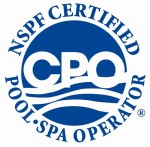Algae
Algae is probably the most annoying water problem in outdoor pools, since it is so unsightly and difficult to destroy quickly. In many cases, several treatments and daily brushing may be required to successfully eliminate an algae problem. Algae multiplies rapidly, and by the time the human eye notices it, there are already billions of algae cells in the pool.
Most pool professionals will agree that the two most frequent complaints received about pools are related to algae and cloudy water. Green algae can make a pool especially cloudy. Algae will clog filter systems and make pool surfaces slippery. The three most common colors of algae are green, black and mustard (yellow). The best way to avoid an algae problem is to keep at least 1.0 ppm of free available chlorine circulating throughout the pool water at all times. For persistent algae problems, an algaecide may be used.
| COLOR | GREEN ALGAE | BLACK ALGAE | MUSTARD ALGAE |
| APPEARANCE | Pea green colored. Sometimes colors entire body of water. Also attaches to pool surfaces | Better known as “black spots” on pool walls & surfaces. | A yellow film usually found on steps or walls. |
| CAUSES | Insufficient or inactive levels of sanitizer. Inadequate water circulation. High nitrate and phosphate levels. | ||
| TREATMENT | 1. Check pH & adjust if necessary | 1. Brush affected areas thoroughly | 1. Brush affected areas thoroughly. |
| 2. Shock treat pool water | 2. Spot treat affected areas with sanitizer. | 2. Spot treat affected areas with sanitizer. | |
| 3. Brush surfaces if necessary | 3. Shock treat pool water & later add algaecide. | 3. Shock treat pool water or use a specialized mustard algae treatment. | |
| 4. Retest pH & repeat treatments if necessary. | 4. Brush & vacuum as necessary. | 4. Retest pH & repeat treatments if necessary. | |
Notes:
- Always consult a pool professional first if any treatment procedures are unfamiliar.
- Regular algaecide treatments are recommended for outdoor pools that experience persistent algae problems.
Cloudy Water
Cloudy pool water is an unfortunate, but common problem in swimming pools. The usual causes of poor water clarity are improper filtration, and/or improperly balanced water. An algae condition, or severe chloramine condition can cause cloudy pool water.
If the water is cloudy, the operator should first check the filter system. If backwashing does not decrease pressure to the normal operational level, the filter may need cleaning. Clean the cartridge and DE filters according to the manufacturer’s instructions. Inspect the sand in the sand filter for clumps or air pockets. Consult your local professional if you are not familiar with filter maintenance. (Note: never release pool water to any environmentally sensitive areas.)
After a thorough evaluation of the filter system, the water balance should be checked. Look for signs of high calcium hardness, pH, TDS, and alkalinity levels.
| CAUSES | POOR FILTRATION | ALGAE GROWTH | UNBALANCED WATER | UNBALANCED WATER |
| HIGH | HIGH | |||
| CONFIRMATION | Slow filter turnover rates. | Hazy pool water with slight green appearance. | 1. Calcium Hardness | 1. pH |
| 2. TDS | 2. Alkalinity | |||
| TREATMENT | 1. Backwash & clean filter. Determine if filter media needs replacement. | 1. Super-chlorinate & brush pool surfaces. | 1. Replace a portion of the pool water with fresh water of lower hardness and TDS. | 1. Add dry acid or liquid acid to reduce pH to 7.2 – 7.6 & alkalinity to 80-120. |
| 2. Run filter for 24 hours. |
Notes:
Consult a pool professional if a cloudy condition persists. The pool professional may recommend repeated treatments or the use of a clarifier.
Colored Water
Colorless pool water is everyone’s goal, but there are those instances when it is difficult to achieve. Colored water is an ugly nuisance and can result in stained pool surfaces. The two main reasons for colored pool water are oxidized metals and algae. A turbid green pool water condition is usually attributed to algae. To gain a better understanding of algae treatments see the section on algae.
Water color resulting from oxidized metals can come in an assortment of colors, and is mostly translucent in its early stages. Green, red, brown, and black are some of the more common colors produced by dissolved metals. Green color is usually produced by either copper or iron. Red and brown colors are generated by iron. Black/brown pool water is usually caused by manganese.
Often these colored water conditions appear after a pool is initially filled or after a shock treatment. If the fill water contains metals, it should be treated with a sequestering agent and/or clarifier prior to chlorine additions. A shock treatment can cause metals to oxidize, which allows them to fall out of solution and become more visually apparent.
| COLOR | GREEN | GREEN | RED/BROWN | BLACK |
| CAUSES | Algae, if cloudy. | Iron or copper corrosion or in water supply. | Iron corrosion or in water supply. | Manganese in water supply. |
| TREATMENT | 1. Brush. | 1. Adjust pH & alkalinity to recommended ranges. | ||
| 2. Shock treat & brush. | 2. Add sequestering agent & run filter. | |||
| 3. Vacuum. | 3. Two days later, shock treat the water. | |||
| 4. Retest pH & alkalinity. Also test hardness levels &, if necessary, raise to 200 ppm, minimum. | ||||
Notes:
Take a pool sample to a pool professional for dissolved metals testing immediately after treatment and at least once a month.
Stains
When stains appear on swimming pool surfaces, immediate action should be taken to avoid costly and annoying repairs. Brushing can often remove fresh stains if recognized early enough. Neglected stains in plaster pools may ultimately require draining and an acid wash. Like colored water, stains are the result of metal ions in pool water. Stains indicate that either the source water contains metals, such as copper, iron, or manganese, or that a corrosive pool water condition is dissolving metal pool components.
The first step after noticing a pool stain is to determine what caused the stain. This is done by having your local dealer or service professional test the pool water for metals. If the stain is caused by metals, the dealer may recommend either a sequestering agent or clarifier to treat the problem. If metals are present due to improper pH levels, the pH should be adjusted to be within the range of pH 7.2-7.6. If the problem persists, add a sequestering agent or a clarifier that will chemically bind the metals so that they can be filtered out before they cause more staining problems.
| COLOR | BLUE/GREEN | RED/BROWN | BLACK |
| CAUSES | Copper or iron corrosion or from water supply. | Iron or manganese corrosion or from water supply. | Manganese in water supply. |
| TREATMENT | 1. Adjust pH & alkalinity to recommended ranges. | ||
| 2. Vigorously brush the stained areas. | |||
| 3. Add sequestering agent & run filter. | |||
| 4. Two days later, shock treat the water. | |||
| 5. Retest pH & alkalinity. Also test hardness levels &, if necessary, raise to 200 ppm. | |||
Notes:
Take a pool sample to a pool professional for dissolved metals testing 24-48 hours after treatment and at least once a month.
Scale Formations
Crusty, white deposits on pool surfaces signal a severely high level of one or more of the water balance factors. Scale deposits not only make pool surfaces rough, but also reduce water circulation as scale builds up within the filter and plumbing system.
If scale deposits are readily noticeable on pool surfaces the pH, calcium hardness, and total alkalinity must be tested and adjusted immediately. Most likely one factor, if not all three, is much too high and needs to be reduced. The first step is to reduce the pH and alkalinity, since reducing the calcium hardness level is more difficult.
If high hardness is the cause of the scale, it is best to drain a portion of the pool water (or all of the water in a spa) and replace with fresh make-up water that is low in hardness and total dissolved solids.
| CONFIRMATION | Crusty deposits on pool surfaces. |
| CAUSES | 1. High calcium hardness. |
| 2. High pH & alkalinity. | |
| TREATMENT | 1. Adjust pH and alkalinity to ideal ranges (7.2 – 7.6 & 80 – 120 respectively). |
| 2. Replace a volume of pool water with water low in hardness. Consult a pool professional to determine the replacement amount. | |
| 3. Use a sequestering agent to prevent scale buildup if high hardness levels are a continuing problem. |
Eye & Skin Irritations
Eye and skin irritations are another common problem for swimming pool bathers. In addition to such irritations within the water, nasal irritations can also be noticed in indoor pool areas with poor ventilation and excessive levels of combined chlorine, also known as chloramines.
There are two basic causes of eye and skin irritations: improper pH and high chloramines. The human eye is most comfortable in water with a pH of about 7.5. Therefore a low pH, below 7.2, or a high pH, above 8.0 can become quite irritating.
A chloramine problem is caused when combined chlorine levels exceed 0.2 ppm. Though many people incorrectly blame high chlorine for stinging eye irritations, it is actually the presence of chloramines.
| CAUSES | High or low pH | Combined Chlorine |
| TREATMENT | Adjust pH to recommended range & retest. | Shock treat or superchlorinate. |




